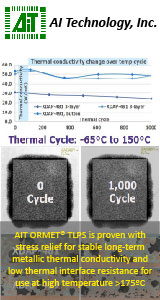|

|
|
| Ask the Experts | |||||||
|
|||||||
|
October 23, 2006 - Updated July 4, 2007 - Originally Posted Wave Soldering creating blowhole problemsWe are experiencing significant blowhole problems on some of our products after the wave solder operation. Several of the blowhole boards were micro-sectioned to determine the cause of the failure. The barrel walls were all intact and there were no signs of voids however, you could see where the blowholes were forming in the barrel. If the barrel is intact and there is no sign of voids, what could be causing this problem? Scott McAllister |
|||||||
| Expert Panel Responses | |||||||
|
The most common causes of blowholes is expansion of a liquid or gas at high temperatures escaping through the solder, leaving behind a hole. It sounds as if you looking for one of the more common causes for blowholes, which is material escaping from within the PCB layers, through the plating and into the molten solder. Sometimes these cracks or holes in the plating can be hard to find, if they are not viewed in a single cross section, that doesn't necessarily rule them out. Does transmission X-ray of these PTHs show any disjointed Are the boards going through any sort of washing (solvent or DI) process prior to the wave soldering process? If so if these are not completely dried, liquids can be trapped within the PTHs and lead to blowholes. Another cause can be a water based flux that isn't completely dried/evaporated can expand and cause the same effect.
Application Engineering Henkel Electronics Dr. Brian Toleno is the Application Engineering Team leader for Henkel Technologies. He is responsible for the technical service and application engineering for Henkel's electronics assembly materials, including solder paste, underfills, PCB protection materials, and underfills.
Blowholes are caused by outgassing of flux, mositure or other organics in the PTH. So I don't understand your statement that there was no indication of voids but you could see where the blowhole was forming. A void will form first and if there is enough outgassing and pressure it will become a blowhole. If there is no indication of a breach in the wall of the PTH (they are very hard to find sometimes) then the problem could be trapped flux or organics in the PTH. The through hole component could be capping the top of the PTH and this would trap the flux and cause a blowhole. If the problem is moisture in the board and you missed the breach in the PTH then baking the boards in a oven at 150 C for 8 hours should care that issue.
Senior Applications Engineer Speedline Technologies Greg joined Electrovert in February 1984. Based out of the Electrovert applications laboratory in Camdenton Missouri, Greg has been in the process applications support role since 2000. His primary responsibilities include providing process and machine applications support for the wave soldering lines as well as process, machine and operations training. He also provides applications support for the reflow and cleaner lines. Greg is a PBET certified trainer and holds two patents on wave solder nozzle design.
Is this lead free solder or tin/lead? In lead free it seems that blow holes or surface voiding is more common. This is due to the surface tension of the alloy as well as interaction with the flux. In general lead free solder needs a more aggressive higher solids content flux than tin lead to get the same results. Temperature of the board may be another issue as well as dwell time in the wave. Another contributing factor is the board surface finish. If it is plated with gold, silver or tin there could be organics or salts from the plating bath trapped in the plating. This would not show up in a cross section. When the solder fills the barrel the organics or salts will erupt and blow the solder out. This also occurs sometimes on SMT double sided boards where the first side to be assembled will form blow holes after the component is on it and it is reflowed a second time. Check you plating, check your flux to make sure it is compatible with lead free if you are soldering with lead free. Also run a longer dwell if it is lead free try 5 seconds. If you are soldering with tin/lead check the plating this can be tested with SEM to look for inclusions in the plated finish.
Deck Street Consultants In his 32 years of industry experience, Mr. Seelig has authored over 30 published articles on topics including lead-free assembly, no-clean technology, and process optimization. Karl holds numerous patents, including four for lead-free solder alloys, and was a key developer of no-clean technology.
|
|||||||
| Submit A Comment | |||||||
|
Comments are reviewed prior to posting. You must include your full name to have your comments posted. We will not post your email address. |
|
Free Newsletter Subscription
Circuitnet is built for professionals who bear the responsibility of looking ahead, imagining the future, and preparing for it. Insert Your Email Address |
|

|





